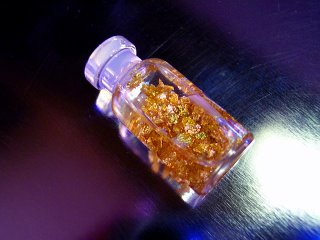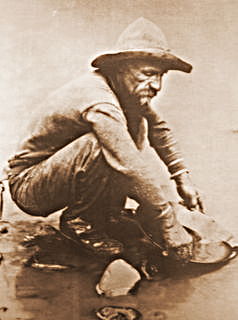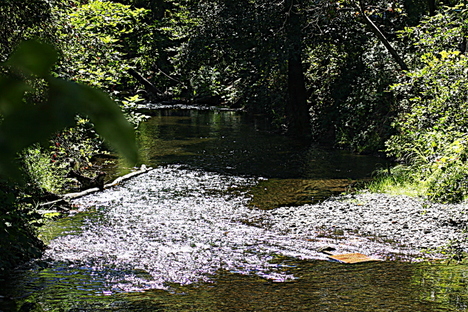Discovering the Adventure
Panning for Gold in Northern California
Got a Hankerin' to Do Some Gold Panning?
You've come to the right place! Panning for gold is becoming more and more popular again - for several reasons. Not least of which is the price of gold these days!
Collect even an ounce of gold and sell it for $1310 (the current per ounce price as of publication) - that'll pay a lot of grocery bills during hard times or good!
Gold panning is also popular because it's so easy to started and doesn't require much in the way of financial investment or equipment.
If truth be told, all you really need is a pie pan and a stream. Of course, it wouldn't hurt to have some idea of how to go about it.
And that's where we come in! Having lived in and near Gold Country for most of our adult lives, it would be difficult not to have developed an appreciation for California Gold Rush history.
It would be equally difficult not to have picked up some tips and Insider Secrets on how to pan for gold! So, here's what we've learned and what we're happy to share with you.
Here's a video from our grandson, Jack who is eight years old - he loves to pan for gold and search for other treasures like diamonds and sapphires and fossils.
Panning for Gold
I Don't Know About You, But the Recession's Not Over for Us
Panning for gold is one of the methods used in placer mining - mining river soil for minerals."
And, although it's hard work, gold panning has the advantages of being easy to learn and very inexpensive.
Anyone can do it!
Today, what with the economy in a slump, people losing their jobs and still unemployed, and gold prices being at all-time highs - $1310 per ounce at press time - more and more people are turning to the rivers and stream beds of Northern California and panning for gold!
And this year (2014), California is suffering from a severe drought and all our waterways are at record lows.
How does that help? River bottoms and stream bottoms where gold may have been deposited in the past, and that are normally covered in water, are now accessible to the casual panner.
What used to be called recreational panning is taking on a more serious slant! It's said that, in spite of all the gold that was discovered and extracted during the California Gold Rush, as much as 80 percent of the gold that existed in California remains in the ground.
And there's the rub... most of it is underground. However, what's
underground often gets brought to the surface by heavy Winter and
Spring storms. So gold panning in California is still a worthwhile
adventure!
Panning for Gold
Do You Know How to Start?
- Find a Good Spot; But Don't Claim Jump
It's very important that, in finding your special spot to pan for gold, you don't work someone else's claim! Also, if your spot is on private property, be sure to get the owner's permission first. - Dig and Classify
Use of a classification screen to rid your gravel/dirt mix of the larger rocks and stones, leaving behind mostly dirt, will speed up the work. - Load the Pan
Now you have lots of dirt and some smaller gravel bits to load into your pan and take to the water. - Loosen and Liquefy
The point of the process is to keep the gold in the pan while getting rid of all the extraneous stuff. Washing your pan load in the water is what turns the trick for you because gold is heavier than water, dirt, and pretty much everything else in your pan. - Shake Down Heavy Stuff
Start shaking your pan, kneading the dirt, and washing the water over and through your pan to shake the heavy stuff to the bottom. - Sweep Out Light Stuff
Wash, shake, swirl - whatever it takes to sweep the light stuff out of your pan. You really don't have to be too careful at this stage, as the gold will be sinking more and more to the bottom. - Use the Riffles to Catch Black Sand
You don't really need a true gold panning pan, but it helps because of the ability of the riffles to trap the black sand and the gold. Now the gentle swirling begins. - Black Sand at Bottom
Now we're getting serious! Keep gently swirling and moving more and more of the black sand out of your pan, leaving the gold flakes and nuggets behind. - See the Gold?
You can decide for yourself when to stop - if you have any nuggets in the pan, you can generally pick them out with your fingers. - Use Sniffer Bottle to Pick Up Flakes
Don't make the mistake of thinking the flakes aren't worth bothering with! At $1310 per ounce, they can add up - so make sure you get them all! - And finally - Good Luck!
Panning for Gold
Do You Know Where to Start?
First of all, you want to find a stream or creek with a history of producing placer gold. It means that somewhere along it's course there are gold deposits. And that's important when you're panning for gold!
Your spot should be on public land where recreational prospecting is allowed, or you should have the owner's permission if the land is privately owned.
The area you want to dig and the place you choose for panning will most likely not be the same place, or even close to each other, so plan on getting a little exercise.
For digging, find a spot where the water has been forced to slow down - that's where the gold will have dropped to the bottom because of its weight. Try the inside of a bend, under and behind a large rock, or downstream of a fast-moving rapids where the water has slowed back down.
For your panning operation, choose an area of your waterway with deep enough water that you can submerge your pan completely. You'll also want the water to flow enough to move the silty stuff downstream, but not so fast as to make panning difficult.
That's all there is to it! If a spot you've chosen doesn't seem to be panning out (now you know where terms like "it didn't pan out" come from), try somewhere different next time. That's what the 49ers did!
Panning for Gold
Do You Know Real from Fool's?
 Vial of Gold; © Jane A. Sawyer
Vial of Gold; © Jane A. SawyerEver wonder if you would recognize real gold if you saw it? Me too! I was also afraid I'd throw out what I thought was Fool's Gold only to have it be the real thing!
James Marshall and John Sutter tested the gold found by Marshall by various means such as pounding it with a hammer, boiling it in lye, and dunking it in aqua fortis (nitric acid). Apparently they weren't anymore sure how to identify gold than you or I!
These more modern tips should help you distinguish between the real glitter and the faux glitter when you're panning for gold:
Probably the easiest way to tell these two minerals apart is what I like to call the "Streak Test" (No, you don't have to streak across the room with no clothes on...)
- Carry a small piece of white tile with you when you're panning for gold; scratch your nugget on the back of the tile (the unglazed side) - if the streak is golden-yellow, it's gold; if the streak is greenish-black, it's Iron Pyrite or Fool's Gold
- Try to scratch a piece of glass with your nugget - if it's gold, it won't make a mark on the glass because gold is softer than glass
- Hold a magnet next to the nugget - if your nugget is attracted to
the magnet, it's not gold - Use a gold testing kit, which will contain test acid, a gold test stone, a test needle set, and salts
- So there you have it! Grab that pie plate and off you go! Try panning for gold and see if you can't find a little something extra to help you out in these hard times.
Interested in the history of the California Gold Rush? Here you are!
- Discover the California Gold Rush
Has your heart ever skipped a beat at the thought of discovering gold? Then you know how the California 49ers felt! Come along and Discover the California Gold Rush with us...
Please continue your exploration of what Northern California has to offer by using the Nav Bars in the left and right columns or by using the links at the bottom of the page.
Like what you're finding here at Discovering Northern California? Then please share with the Social Network of your choice.
And thanks for coming!
- Home Page
- Gold Panning
Related Pages
California Gold Rush
California Gold Rush
Discovery of Gold
Getting to California
Gold Rush Trail
Gold Rush Sites
Gold Panning
Related Pages
More CA History
1906 Earthquake
California Gold Rush
CA Gold Rush Sites
California Missions
Sonoma Plaza History
Sutter's Fort
Related Pages
Things To Do
Activity Village
Attractions
Beaches
Beer Lovers Delight
Burney Falls
Camping
Casa de Fruta
Day Trips
Gold Panning
Gold Rush Sites
Healdsburg
Historic Grass Valley
Lake Shasta Caverns
Lodi
Missions
Nevada City
RV Destinations
Ski Resorts
Tide Pool Tips
Travel Tips
Weekend Trips
Whale Watching
Wine Tasting
Related Pages
Insider Secrets
Best Kept Travel Secrets
Best Winter Whitewater
Boring Road? Nope
CA Admission Day
Climbing at Castle Rock
Crabbing Spots
Dream of Dreams
Fall in Eastern Sierras
Ghost Stories
Glass Beach
Great Stays, Low Pays
How to be a Valley Girl
Jade Beach
Lake Shasta Caverns
Lassen Volcanic SP
Lost Coast
Mono Lake
Moss Landing: Whales
New Clairvaux Abbey
Panning for Gold
Pygmy Forest
Mendo to Eureka
RV Destinations
SF Great Places to Eat
SF: More About Eating
SF Neighborhoods
SF Giants Baseball
Santa Cruz: Memories
Santa Cruz: Old Friends
Sonoma Cooking Class
Sonoma History
Sonoma Top Wine Stop
Tahoe: Discovery Trail
Underground Gardens
Yosemite: Family Hikes
Yosemite: High Country
YNP: Off the Beaten Path
Yosemite: Taft Point
Ziplines

